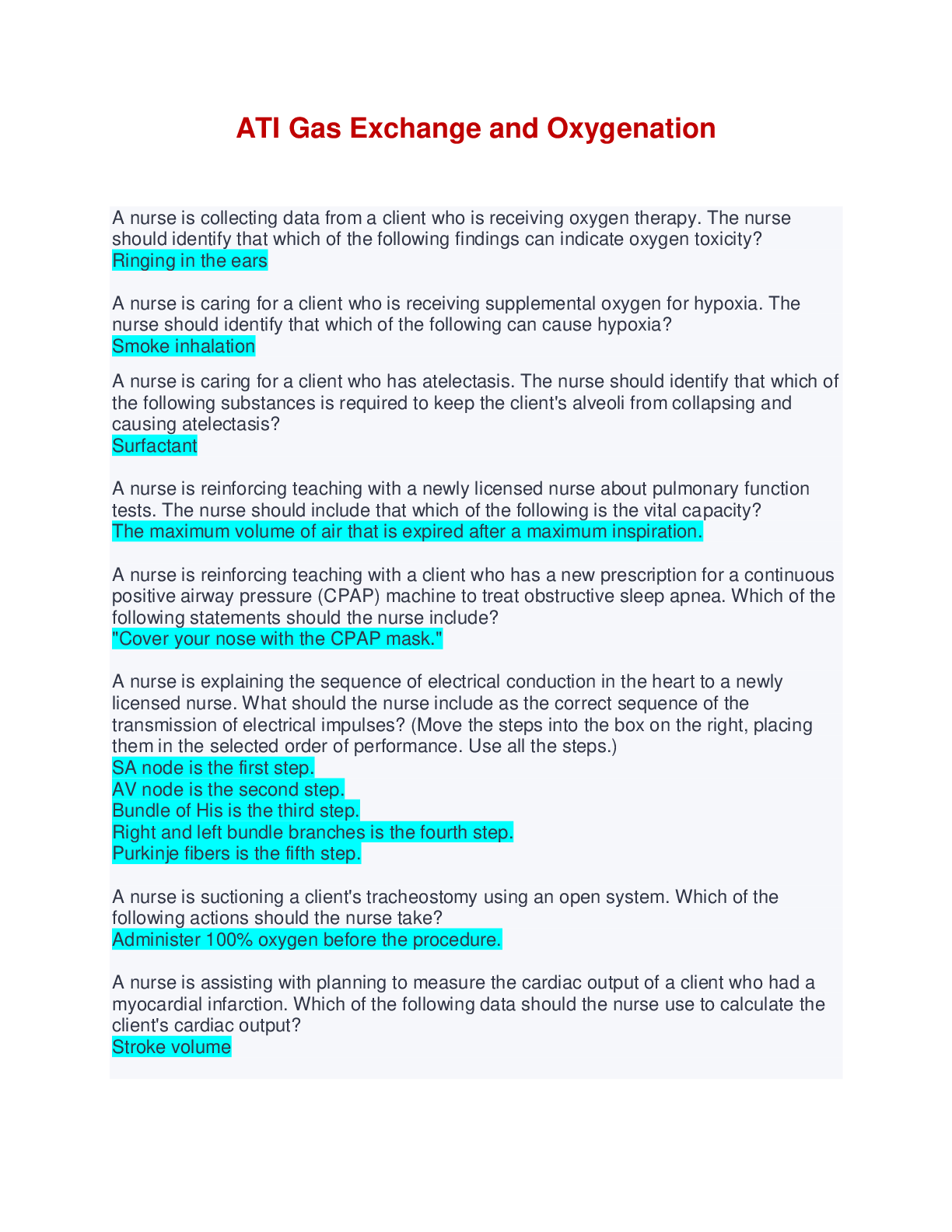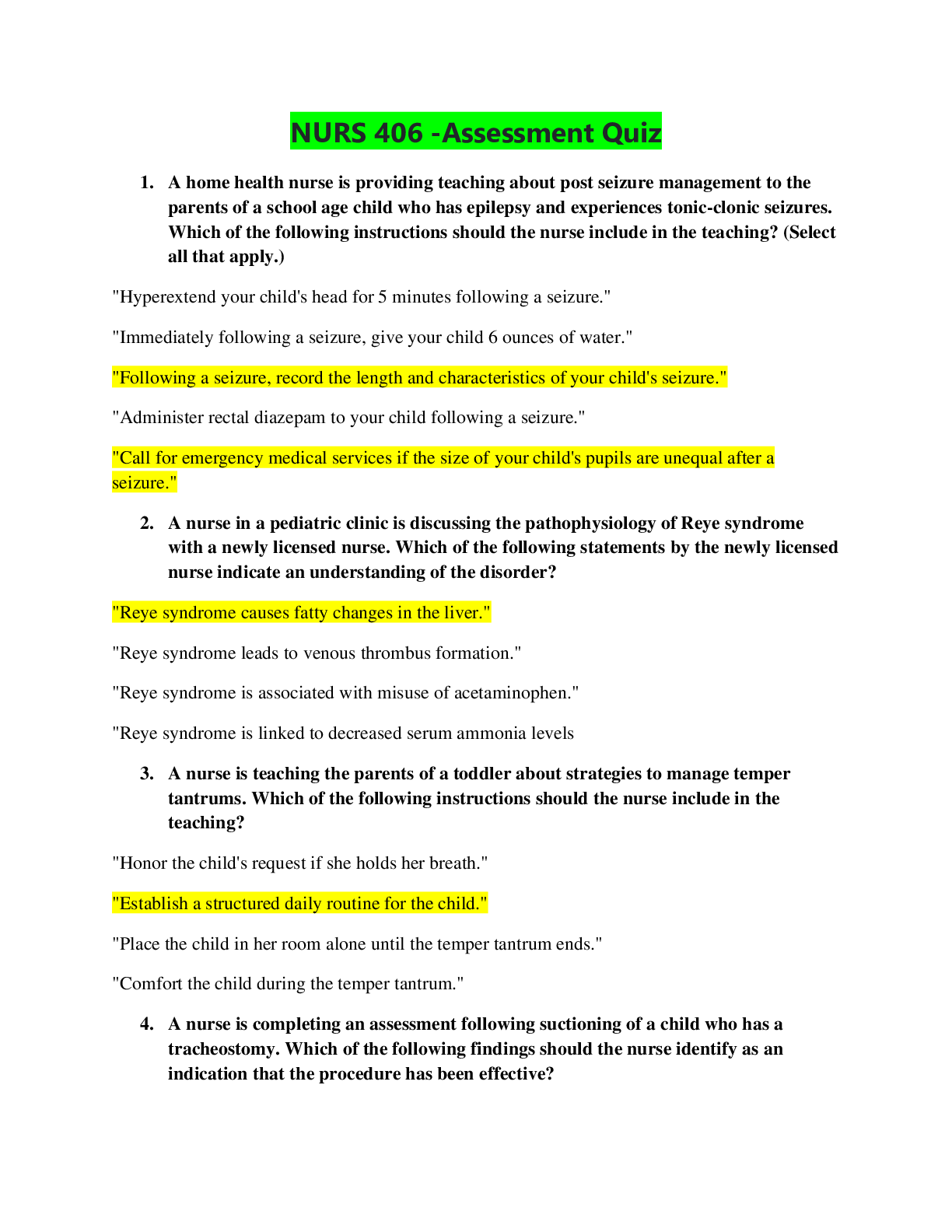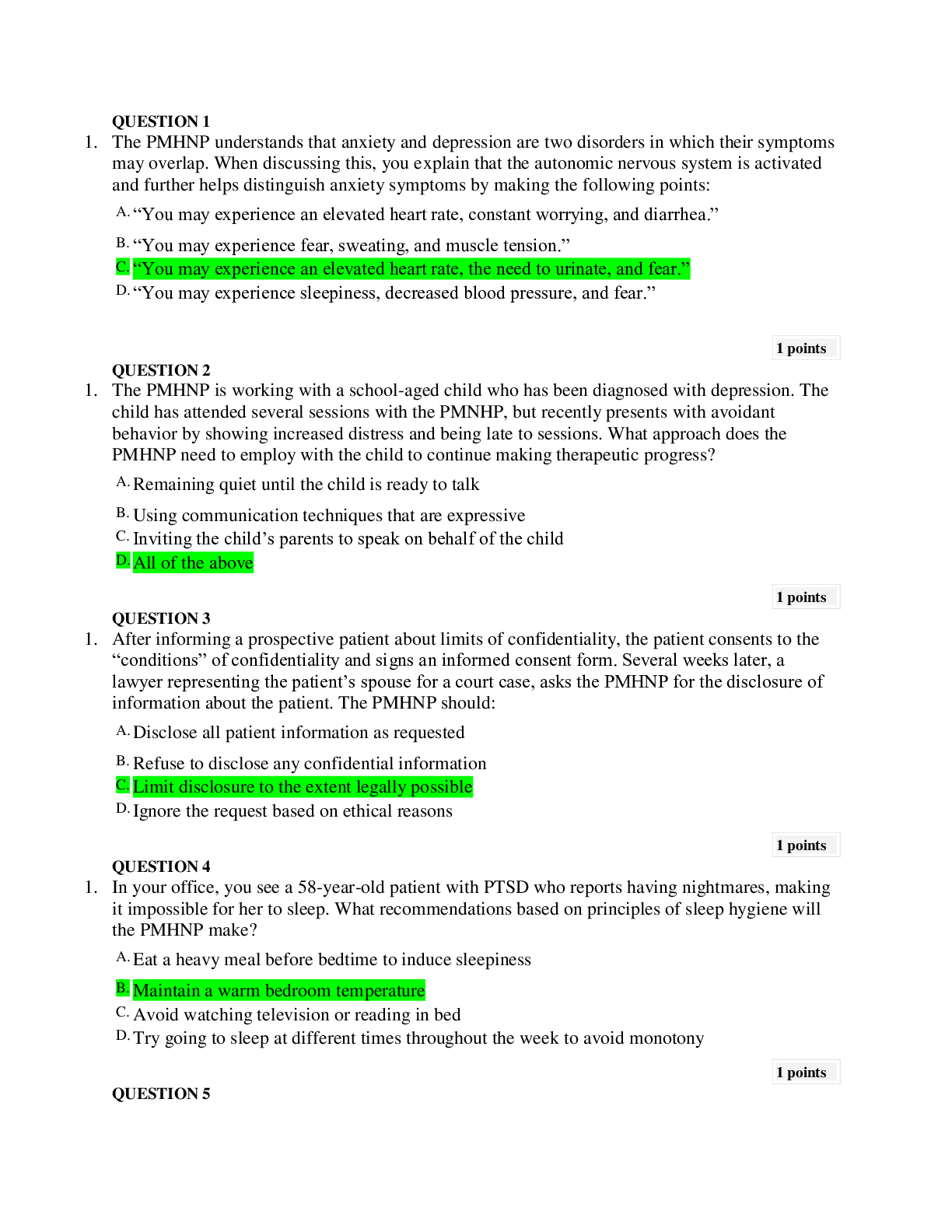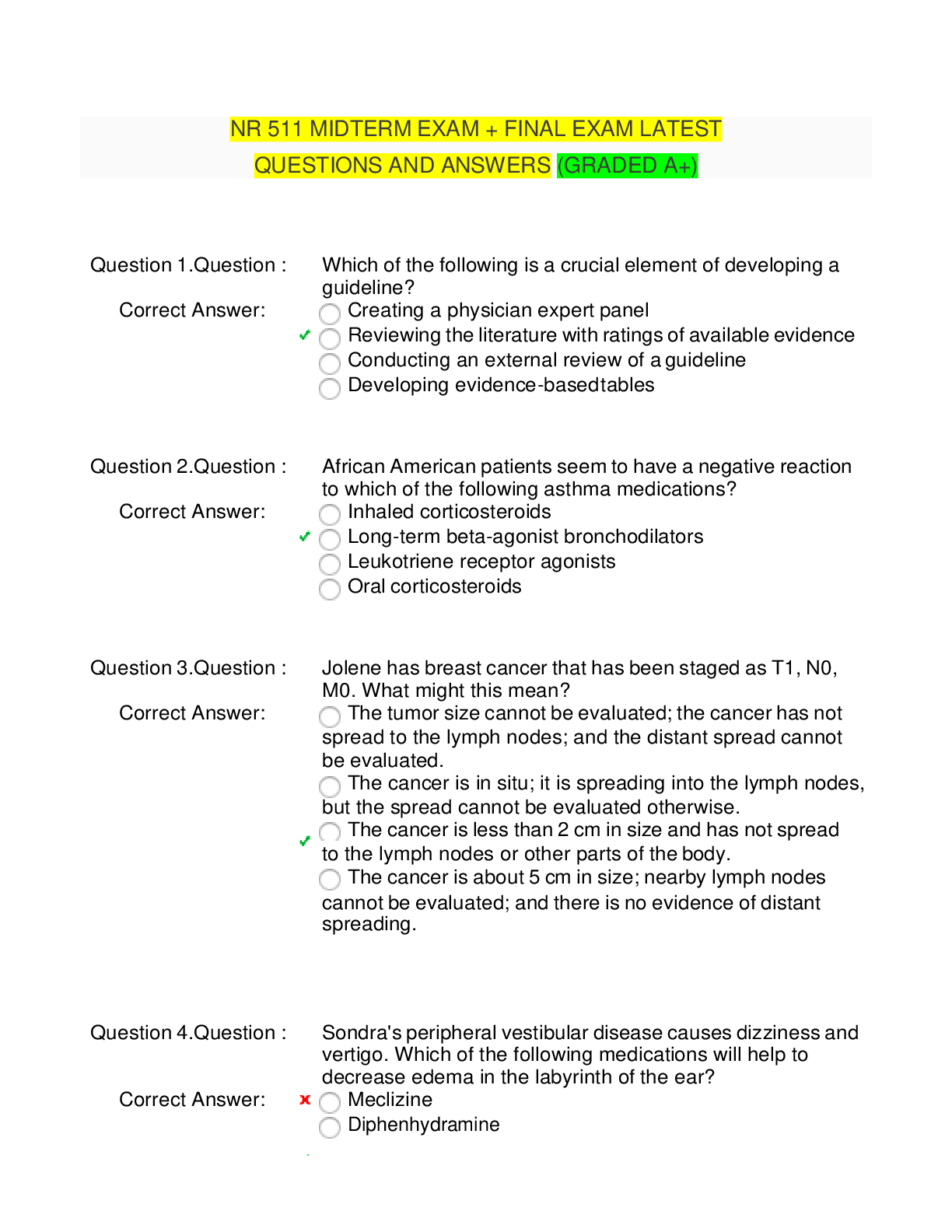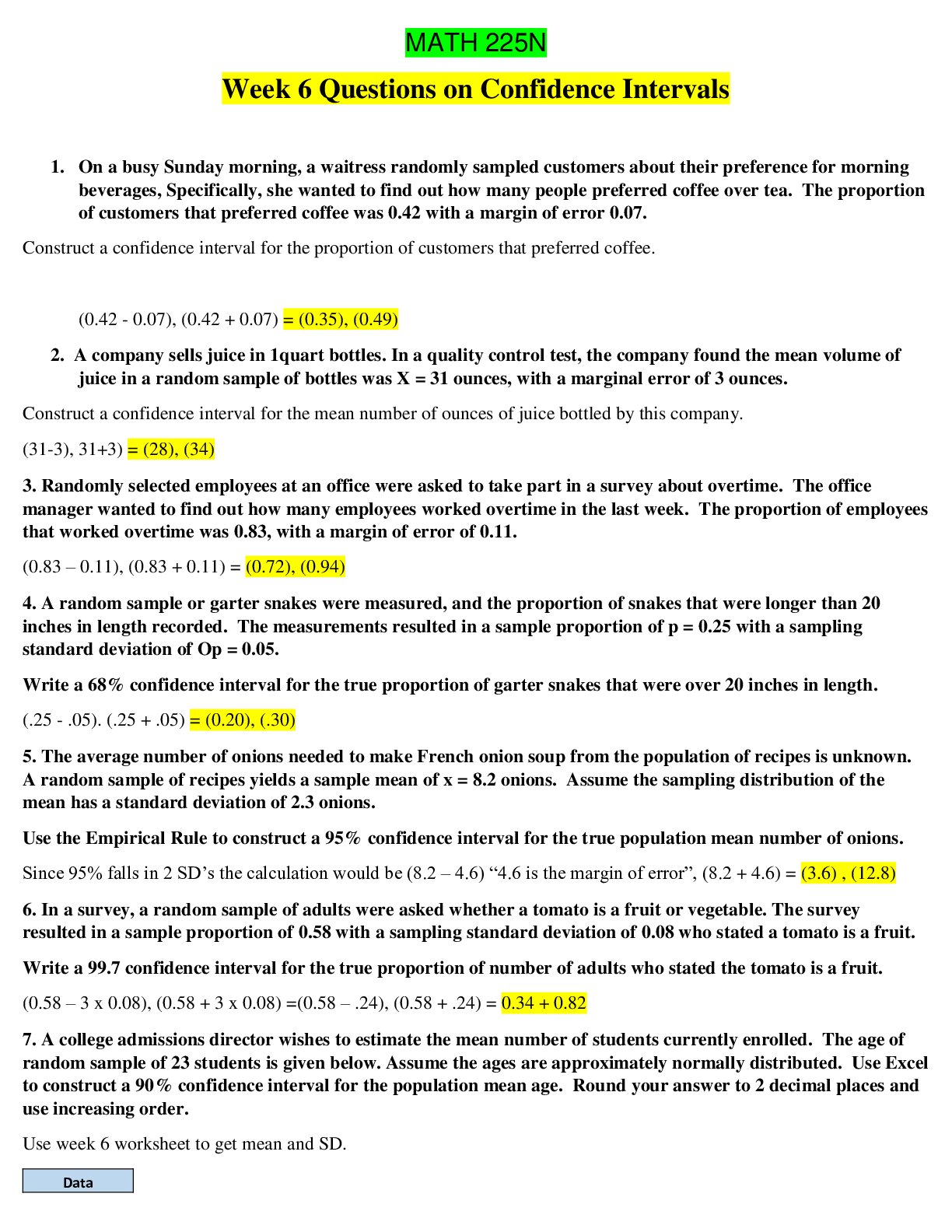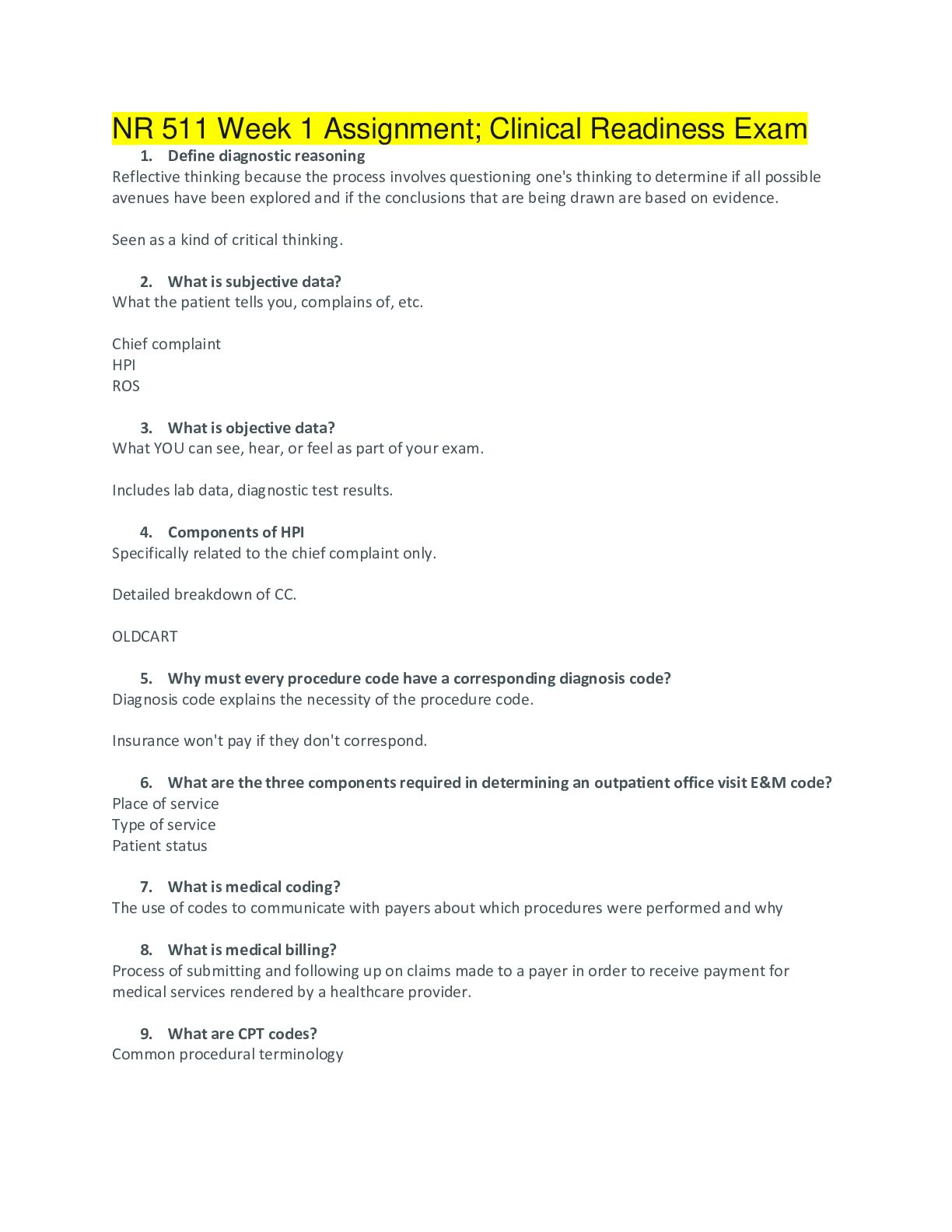SPED 435 Midterm Exam | Questions and Answers (Complete Solutions)
Document Content and Description Below
SPED 435 Midterm Exam | Questions and Answers (Complete Solutions) Assessment in special education is a process that involves collecting information about a student for the purpose of making decisio... ns. True False The process of tracing and gathering information from the many sources of background information on a child such as school records, observation, parent intakes, and teacher reports is called: a. Collection b. Analysis c. Evaluation d. Determination The processing and understanding of patterns in the child's educational, social, developmental, environmental, medical, and emotional history is called: a. Collection b. Analysis c. Evaluation d. Determination The assessment of a child's academic, intellectual, psychological, emotional, perceptual, language, cognitive, and medical development in order to determine areas of strength and weakness is called: a. Collection b. Analysis c. Evaluation d. Determination The measurement of the presence of a suspected disability and the knowledge of the criteria that constitute each category is called: a. Collection b. Analysis c. Evaluation d. Determination The final thoughts and ideas concerning educational placement and program that need to be made to the school, teachers and parents are called: a. Collection b. Analysis c. Evaluation d. Recommendations Valuable information about the student's skills and needs can come from: a. Parents b. Teachers c. Specialists d. All of the above can give valuable information about a student's skills and needs Which of the following is the primary purpose of assessment? a. Screening and identification b. Evaluation c. Eligibility and diagnosis d. All of the above serve as primary purposes of assessment Prior to 1975 in the United States, discrimination against those with disabilities was prevalent in schools. The type of discrimination most evident was: a. The exclusion of students with disabilities altogether from school b. The classification of students with disabilities when, in actuality, no disability was present. c. Both a and b d. Neither a or b. Brown v. Board of Education: a. Set the precedent for future discrimination cases in education. b. Helped students with disabilities in the future claim that their segregation and exclusion from school violated their opportunity for an equal education under the 14th amendment of the US constitution c. Both a and b d. Neither a nor b Which case involved the ideas that schools may not exclude students who have been classified with mental retardation and that all students must be provided with a free public education? a. Diana v. Board of Education b. Parc v. Commonwealth of Pa. c. Mills v. Board of Education d. Larry P. v. Riles Which case set forth future guidelines of P.L. 94-142, including the rights of students with disabilities to have access to a free public education and a mandated requirement to receive special education services even if the school states that it does not have the money to provide them? a. Diana v. Board of Education b. Mills v. Board of Education c. Larry P. v. Riles d. Pase v. Hannon Section 504 of the Vocational Rehabilitation Act is a civil rights law enacted in a. 1973 b. 1980 c. 1990 d. 1993 In 1975 Public Law ______ set forth federal procedural safeguards for children with disabilities and their parents. a. 91-564 b. 101-931 c. 94-142 d. 100-32 The federal law requiring all states to provide a free and appropriate public education to children with disabilities from age 3 to 5 years. a. 99-457 b. 101-342 c. 94-132 d. 331-76 An evaluation of a child with a suspected disability must be made by a multidisciplinary team. True False A developmental disability significantly affecting verbal and nonverbal communication and social interaction, generally evident before age 3 years is called a. Autism b. Learning disability c. Emotional disturbance d. Speech and language disorder A disability where a child of typical intelligence has difficulty, over time and to a marked degree, building satisfactory interpersonal relationships; responds inappropriately behaviorally or emotionally under normal circumstances; demonstrates a pervasive mood of unhappiness; or has a tendency to develop physical symptoms or fears is called: a. Autism b. Learning disability c. Emotional disturbance d. Speech and language disorder A disorder in one or more of the basic psychological processes involved in understanding or in using language, spoken or written, which may manifest itself in an imperfect ability to listen, think, speak, read, write, spell, or do mathematical calculations is called: a. Autism b. Learning disability c. Emotional disturbance d. Speech and language disorder Asthma, epilepsy, lead poisoning and diabetes are examples of disorders which would most likely receive a classification of: a. Autism b. Learning disability c. Speech and language disorder d. Other Health Impairment A _________ is a large number of children who are representative of all children in that age group. a. Curriculum group b. Dynamic group c. Norm group d. Task group A _____ is a starting point that represents the level of mastery of a task below which the student would correctly answer all items on a test: a. Basal b. Ceiling c. Neither a nor b A _____ is an ending point that represents the level of mastery of a task above which the student would incorrectly answer all future items on a test: a. Basal b. Ceiling c. Neither a nor b ______ compare(s) a person's score against the scores of a group of people who have already taken the same exam: a. Norm-referenced tests b. Curriculum based tests c. Task analysis d. Dynamic assessment The phrase "acceptable level of mastery" normally applies to: a. Norm-referenced tests b. Criterion-referenced tests c. Both a and b d. Neither a nor b A thorough ecological assessment should include: a. Interaction between students, teachers and others in the classroom b. Presentation of materials and ideas c. Selection and use of materials for instruction d. All of the above Curriculum Based Measurement is most concerned with a. Fluency b. Norms c. Neither a nor b d. Both a and b Which of the following involves a test-train-retest approach? a. Ecological assessment b. Dynamic assessment c. Task analysis d. Learning styles assessment Which type of portfolio involves the student, teacher, and parents contributing to it? a. Working portfolio b. Showcase portfolio c. Teacher portfolio d. None of the above Which type of portfolio houses only the student's best work and generally does not include works in progress? a. Working portfolio b. Showcase portfolio c. Teacher portfolio d. None of the above ________ data is categorical data. a. Nominal b. Ordinal c. Interval d. Ratio Numbers on a football jersey are examples of _______ data. a. Nominal b. Ordinal c. Interval d. Ratio _______ scales involve the rank order system. a. Nominal b. Ordinal c. Interval d. Ratio A ________ scale is one in which equal differences in scores represent equal differences in amount of the property measured but with an arbitrary zero point. a. Nominal b. Ordinal c. Interval d. Ratio Distance, weight and duration are all examples of _________ data a. Nominal b. Ordinal c. Interval d. Ratio The _______ is greatly affected by extreme scores. a. Mean b. Median c. Mode d. All of the above are greatly affected by extreme scores The _______ is the middle score in a distribution. a. Mean b. Median c. Mode d. Range The _______ is the number in the distribution that occurs most frequently. a. Mean b. Median c. Mode d. Range A ________ expresses how often a score occurs in a set of data. a. Frequency distribution b. Multimodal distribution c. Non-discriminatory distribution d. Truncated distribution The ________ of a distribution is the difference between the high score and the low score in the distribution. a. Mean b. Median c. Mode d. Range Correlations tell us the _________ between two variables. a. Range b. Standard deviation c. Variance d. Relationship A _________ correlation has a direct relationship between the variables: a. Positive b. Negative c. Zero A _________ correlation has an indirect relationship between the variables: a. Positive b. Negative c. Zero A _________ correlation has no relationship between the variables: a. Positive b. Negative c. Zero Correlations range from _______: a. +1.00 to -1.00 b. -2.00 to +2.00 c. -3.00 to +3.00 d. 0.00 to +1.00 Which of the following is the strongest correlation? a. +.50 b. -.85 c. +.71 d. -.34 Which of the following is the weakest correlation? a. +.50 b. -.85 c. +.71 d. -.34 Correlations _______ indicate a cause and effect. a. Always b. Sometimes c. Almost never d. Never ________ are any information gathered and collected through your research in the assessment process. a. Content validity b. Correlation coefficients c. Data d. Standard scores A child's actual age is referred to as the: a. Mental age b. Chronological age c. Standard age d. Content age When doing an assessment, why calculate age as opposed to just asking children their age? a. Many children do not know when they were born. b. Children think they know their date of birth but are incorrect. c. Ages (when doing psychoeducational assessment) are broken down into years, months and days. d. All of the above are reasons to calculate age as opposed to just asking children their age A student is tested on July 10, 2015. His date of birth is April 20, 2003. His age at the time of testing is: a. 12-3-20 b. 12-5-20 c. 12-2-10 d. 12-2-20 The _______ indicates the number of items correctly answered on a given test. In almost all cases, it is the first score a teacher obtains when interpreting data. a. Standard score b. T score c. Raw score d. z score On a 20 word spelling test, a student got 6 wrong. His raw score is: a. 20 b. 12 c. 8 d. 14 A percentile rank of 95 means that you did as well as or better than _______ percent of the students in the class. a. 5 b. 15 c. 60 d. 95 The _______ percentile normally signifies the average ranking or average performance. a. 25th b. 50th c. 75th d. 95th Normally, standard scores have a mean of ____ and a standard deviation of ____. a. 50/5 b. 100/10 c. 100/15 d. 50/15 A _______ indicates how many standard deviations a score is above or below the mean. a. z score b. T score c. Stanine d. All of the above A _______ is a type of standard score that has a mean of 5 and a standard deviation of 2. a. z scores b. T scores c. Stanine d. None of the above The Responsiveness to Intervention (RTI) process is a __________ approach to providing services and interventions to struggling learners at increasing levels of intensity. a. multi-tiered b. two-way c. one-way d. single level Which of the following is not the purpose of RTI? [Show More]
Last updated: 2 days ago
Preview 5 out of 26 pages

Loading document previews ...
Buy this document to get the full access instantly
Instant Download Access after purchase
Add to cartInstant download
We Accept:

Reviews( 0 )
$18.00
Document information
Connected school, study & course
About the document
Uploaded On
Jul 03, 2024
Number of pages
26
Written in
Additional information
This document has been written for:
Uploaded
Jul 03, 2024
Downloads
0
Views
8


